Happy Birthday, Sammy Kaye!
It was at a Cleveland, Ohio venue known as The Cabin Club where Sammy Kaye—born Samuel Zamocay, Jr on this date in 1910—would acquire the slogan that would make him and his orchestra famous. The Cabin Club’s master of ceremonies liked to give Sammy and his musical aggregation a nice rhyming welcome: “Music in the Rhythmic/Sentimental Way with Sammy Kaye” were two popular catchphrases, but the one that stuck was “Let’s Swing and Sway with Sammy Kaye.” Why? It seems that fans of the band greeted Kaye and his musicians one night with “Hi, Swing and Sway” and Sammy instinctively knew it was a perfect fit.
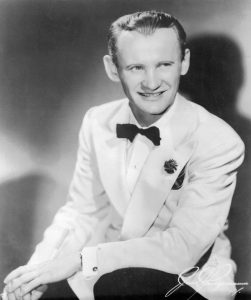 Sammy Kaye entered this world in Lakewood, Ohio and attended high school in Rocky River. Upon graduation, Sammy attended Ohio University (in Athens), intending to earn a degree in civil engineering. To finance his studies, Kaye started a band (he was proficient on both the clarinet and saxophone, though he rarely soloed on either instrument). The group became so popular that, in addition to playing the usual school dances and proms, he opened up his own little “nickel a dance” nightspot: The Varsity Inn. Sammy kept his crew together after college graduation and embarked on a tour. What began with one-nighters at “whistle stops” soon blossomed into gigs at hotels, theatres, and nightclubs.
Sammy Kaye entered this world in Lakewood, Ohio and attended high school in Rocky River. Upon graduation, Sammy attended Ohio University (in Athens), intending to earn a degree in civil engineering. To finance his studies, Kaye started a band (he was proficient on both the clarinet and saxophone, though he rarely soloed on either instrument). The group became so popular that, in addition to playing the usual school dances and proms, he opened up his own little “nickel a dance” nightspot: The Varsity Inn. Sammy kept his crew together after college graduation and embarked on a tour. What began with one-nighters at “whistle stops” soon blossomed into gigs at hotels, theatres, and nightclubs.
In Radio’s Golden Age, hotels often served as a location for “band remotes,” which comprised much of the medium’s musical programming. Sammy Kaye and his Orchestra were just one of the many “big bands” who performed before appreciative hotel crowds and listeners at home. Kaye and his band got their initial start in radio in Cincinnati before relocating to Pittsburgh. Nationally, Kaye and Company began doing remotes for Mutual in 1937, and for the next twenty years would log airtime on all of the major networks (many of his popular series were broadcast as Sammy Kaye’s Sunday Serenade). Most notably, they were heard on CBS’s The Old Gold Program from January 1943 to March 1944 (Wednesdays at 8pm), where Sammy was the bandleader for a half-hour show starring “The Old Redhead,” Red Barber, and later comic actor Monty Woolley. Kaye also headlined a half-hour program for Rayve/Richard Hudnut on ABC from November 1945 to January 1948 (heard on Sunday afternoons), and from 1953 to 1956 held court on Sammy Kaye’s Cameo Room, heard in various formats and time slots on ABC.
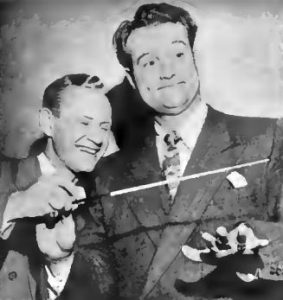 One of Sammy Kaye’s best remembered radio series was born during a two-year engagement that he and his band had in the Century Room at New York’s Commodore Hotel. (Kaye and his orchestra got the gig after another orchestra—fronted by someone named Tommy Dorsey—found work elsewhere.) The story goes that a couple sauntered up to Kaye’s bandstand one evening and the man asked if he could lead the orchestra. “Sure,” joked Sammy, “if you let me dance with your girl.” This moment of levity inspired Kaye to make it a permanent part of the band’s repertoire, and on September 5, 1946 So You Want to Lead a Band premiered over ABC on Thursday evenings at 10. Kaye would select amateur maestros from the audience and hand out prizes to the participants (the grand prize was $1,000). Its run on ABC was brief (the last broadcast was on October 24, 1946), but during that time the program hosted guest celebrities like Betty Grable, Linda Darnell, and Ethel Merman. Sammy continued “So You Want to Lead a Band” in his orchestra’s live appearances afterward (and often used it as a warm-up before radio broadcasts). In fact, he even brought the show to the small screen on ABC-TV in 1954-55.
One of Sammy Kaye’s best remembered radio series was born during a two-year engagement that he and his band had in the Century Room at New York’s Commodore Hotel. (Kaye and his orchestra got the gig after another orchestra—fronted by someone named Tommy Dorsey—found work elsewhere.) The story goes that a couple sauntered up to Kaye’s bandstand one evening and the man asked if he could lead the orchestra. “Sure,” joked Sammy, “if you let me dance with your girl.” This moment of levity inspired Kaye to make it a permanent part of the band’s repertoire, and on September 5, 1946 So You Want to Lead a Band premiered over ABC on Thursday evenings at 10. Kaye would select amateur maestros from the audience and hand out prizes to the participants (the grand prize was $1,000). Its run on ABC was brief (the last broadcast was on October 24, 1946), but during that time the program hosted guest celebrities like Betty Grable, Linda Darnell, and Ethel Merman. Sammy continued “So You Want to Lead a Band” in his orchestra’s live appearances afterward (and often used it as a warm-up before radio broadcasts). In fact, he even brought the show to the small screen on ABC-TV in 1954-55.
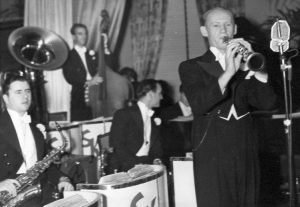 Jazz writer George T. Simon was not a Sammy Kaye fan, describing the maestro’s style as “mickey mouse music”: “[W]here the phrase came from I don’t know, except perhaps that the music sounded as manufactured and mechanized as Walt Disney’s famous mouse—and projected just about as much depth.” (In Kaye’s defense, George was a one-time drummer for rival Glenn Miller’s band, so there may have been a little professional jealousy.) The general public paid little attention to Simon’s opinion; beginning with the appropriate Swing and Sway in 1937, they made certain that Sammy and Company were never missing from the popular music charts. Fans propelled such records as Rosalie (1937), Love Walked In (1938), Dream Valley (1940), Daddy (1941), Chickery Chick (1945), I’m a Big Girl Now (1946), The Old Lamp-Lighter (1946), and Harbor Lights (1950) to the top spot. (Lights would become Kaye’s signature tune.)
Jazz writer George T. Simon was not a Sammy Kaye fan, describing the maestro’s style as “mickey mouse music”: “[W]here the phrase came from I don’t know, except perhaps that the music sounded as manufactured and mechanized as Walt Disney’s famous mouse—and projected just about as much depth.” (In Kaye’s defense, George was a one-time drummer for rival Glenn Miller’s band, so there may have been a little professional jealousy.) The general public paid little attention to Simon’s opinion; beginning with the appropriate Swing and Sway in 1937, they made certain that Sammy and Company were never missing from the popular music charts. Fans propelled such records as Rosalie (1937), Love Walked In (1938), Dream Valley (1940), Daddy (1941), Chickery Chick (1945), I’m a Big Girl Now (1946), The Old Lamp-Lighter (1946), and Harbor Lights (1950) to the top spot. (Lights would become Kaye’s signature tune.)
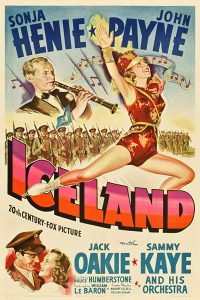 Sammy Kaye and his band also appeared in two motion pictures: Iceland (1942) and Song of the Open Road (1944). On the small screen, the maestro headlined two separate series entitled The Sammy Kaye Show (on CBS in 1951-52 and a summer NBC series in 1953) and Sammy Kaye’s Music from Manhattan (1958-59, ABC). Throughout the 1950s/1960s Kaye continued to be a familiar face on TV, notably as a guest on such programs as Toast of the Town/The Ed Sullivan Show, The Jackie Gleason Show, and The Merv Griffin Show. He was even among the many big band legends in a PBS presentation from 1978 called Big Band Bash. Sammy continued to perform for appreciative audiences before his last swing and sway in 1987 at the age of 77. Before retiring, he put his orchestra in the hands of Roger Thorpe, who continues to wield the baton as of this writing. Sammy was posthumously inducted into The Big Band Hall of Fame in 1992, and his musical legacy in radio, movies, TV, and records earned him a star on Hollywood’s Walk of Fame.
Sammy Kaye and his band also appeared in two motion pictures: Iceland (1942) and Song of the Open Road (1944). On the small screen, the maestro headlined two separate series entitled The Sammy Kaye Show (on CBS in 1951-52 and a summer NBC series in 1953) and Sammy Kaye’s Music from Manhattan (1958-59, ABC). Throughout the 1950s/1960s Kaye continued to be a familiar face on TV, notably as a guest on such programs as Toast of the Town/The Ed Sullivan Show, The Jackie Gleason Show, and The Merv Griffin Show. He was even among the many big band legends in a PBS presentation from 1978 called Big Band Bash. Sammy continued to perform for appreciative audiences before his last swing and sway in 1987 at the age of 77. Before retiring, he put his orchestra in the hands of Roger Thorpe, who continues to wield the baton as of this writing. Sammy was posthumously inducted into The Big Band Hall of Fame in 1992, and his musical legacy in radio, movies, TV, and records earned him a star on Hollywood’s Walk of Fame.
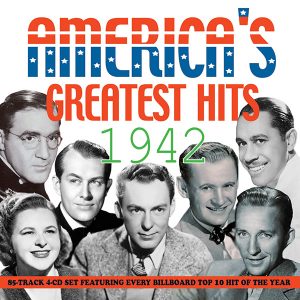 Shortly after the attack on Pearl Harbor on December 7, 1941, Sammy Kaye borrowed the music from Ohio University’s Alma Mater and (with Don Reid) wrote Remember Pearl Harbor, which rocketed to #3 on the pop charts in 1942. You’ll find that classic tune on the 4-CD collection America’s Greatest Hits 1942, as well as another popular Kaye standard, I Left My Heart at the Stage Door Canteen (which also peaked at #3). In addition, Radio Spirits features our birthday boy on the 3-CD set You Make Me Feel So Young (with Sammy’s chart-topping rendition of Love Walked In) and Too Young: Hits of the 1950s, another 3-CD compilation featuring Kaye and band member Don Cornell on It Isn’t Fair (#2 in 1950). Happy birthday, Sammy!
Shortly after the attack on Pearl Harbor on December 7, 1941, Sammy Kaye borrowed the music from Ohio University’s Alma Mater and (with Don Reid) wrote Remember Pearl Harbor, which rocketed to #3 on the pop charts in 1942. You’ll find that classic tune on the 4-CD collection America’s Greatest Hits 1942, as well as another popular Kaye standard, I Left My Heart at the Stage Door Canteen (which also peaked at #3). In addition, Radio Spirits features our birthday boy on the 3-CD set You Make Me Feel So Young (with Sammy’s chart-topping rendition of Love Walked In) and Too Young: Hits of the 1950s, another 3-CD compilation featuring Kaye and band member Don Cornell on It Isn’t Fair (#2 in 1950). Happy birthday, Sammy!


